How to choose running shoes that work for you
Lesson number one: Don't run in cross trainers.
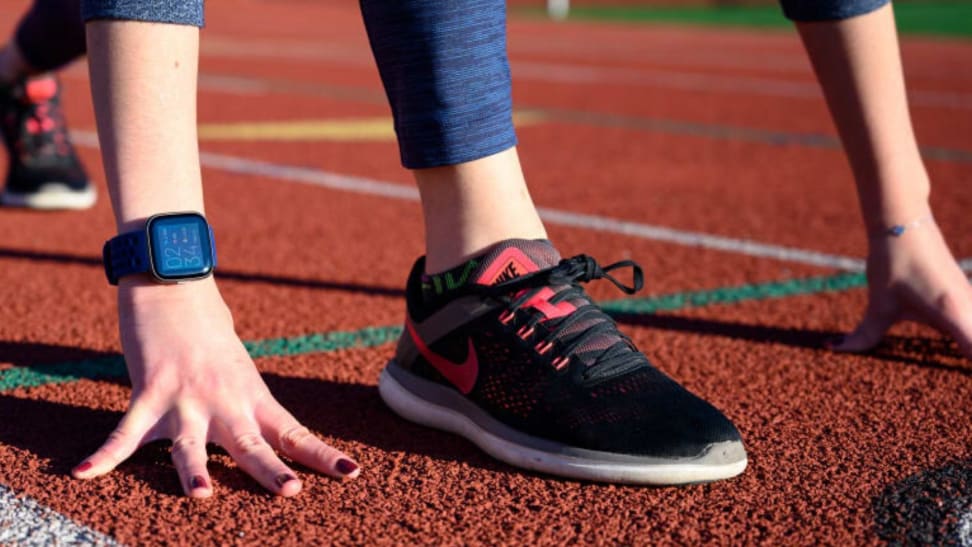 Credit:
Reviewed / Betsey Goldwasser
Credit:
Reviewed / Betsey Goldwasser
Recommendations are independently chosen by Reviewed's editors. Purchases made through the links below may earn us and our publishing partners a commission. Prices were accurate at the time this article was published but may change over time.
As a certified running coach and someone who reviews things for a living, I’m often asked for running shoe recommendations, especially by folks who are beginner runners. My friends (knowing me) expect a long scientific answer, but are surprised when it’s just this: whichever ones feel best on your feet.
There is a much more detailed response, of course—wearing the wrong shoes can set you up for soreness, blisters, or even injuries. So here it is: everything I know that you should know about how to choose running shoes, from style to fit to when to replace them, and some popular models to try out.
Why do you need running shoes?
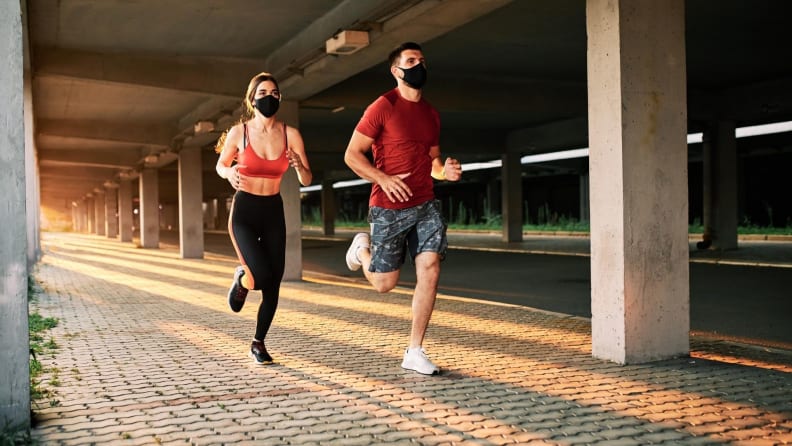
Wearing the right footwear is essential to keeping your feet feeling good and yourself (hopefully) injury-free.
Athletic shoes go by many names, including gym shoes, sneakers, tennis shoes, trainers and, yes, running shoes. But if you intend to run long distances over hard pavement in your shoes, you want ones specifically designed for that purpose.
Running is a mechanically repetitive movement pattern, in which you propel your body forward in a straight line. To drive that momentum, each foot lands (with a force of up to seven times your bodyweight!), rolls through, and pushes off, over and over and over again. What you wear on your feet can protect them and the rest of your body from that impact and from the ground itself, as well as help guide your movement with cushioning that absorbs force and provides rebound for that forward-moving activity.
While cross trainers or other athletic types of shoes might be fine for occasional jogs or HIIT-workout bursts of speed, they just aren’t designed to take the beating of logging mile after mile, nor are they shaped to provide control and encourage efficiency for a forward-only trajectory. This is why you need running shoes—and decent ones from a reputable brand—if you intend to run regularly or even train for a race.
What’s the most important feature to look for in running shoes?
It sounds like a cop-out, but it’s scientifically proven: Your running shoes must be comfortable. The trickier part is determining what’s comfortable, which is really best done by actually wearing and trying out the shoes. If you can get to a running store that has knowledgeable sales staff, a treadmill for gait analysis, and a range of brands and models to try, that’s your best bet. A running coach friend who used to work at one such shop gave me a good tip I keep sharing: Once you’ve narrowed it down to two pairs, put one shoe on each foot and run on the store treadmill or even for a test run outside—whichever shoe you notice less on your foot is the winner.
What are you feeling for? Any pinching, rubbing, poking, or other irritation at all. Even the smallest thing can become a hotspot as you put in the miles. When there’s something underfoot that’s causing discomfort, your entire gait can change to avoid exacerbating that, which can lead to potentially more serious injuries.
How should running shoes fit?
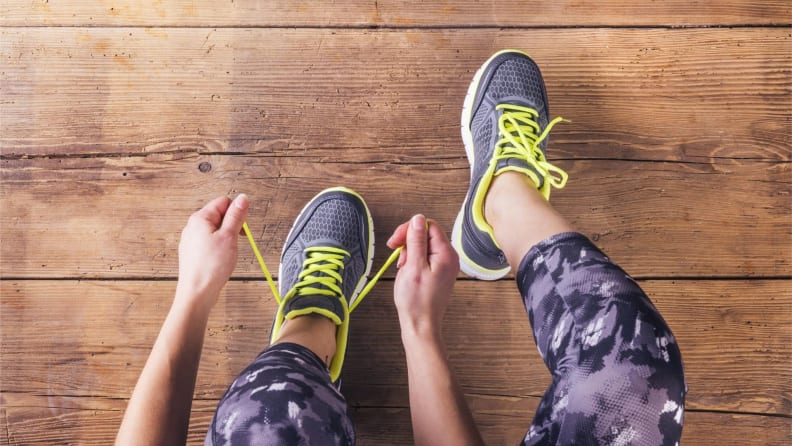
You can customize the fit of your shoes using various lacing techniques.
Two words: black toenails. For that reason (and its cousin “lost toenails”), you will likely go at least a half-size larger in running shoes than you normally wear. Still, sizing can vary, so remember this rule of thumb: When standing up, you should be able to press on the end of the shoe and measure a good thumb’s width of space from your longest toe.
In terms of width, that’s more of a personal preference. Some like the feeling of a snug fit, while others want plenty of wiggle room for toes to splay. Your feet will swell as you run, though, which can contribute to an overly tight feeling and even foot numbness, so erring on the side of a little wider and looser can be more comfortable. What you don’t want is a too-wide heel cup for the backs of the feet to slide up and down and chafe against.
You can compensate for some extra roominess with various shoe-lacing techniques. Adding insoles can also take up some room and provide more support through the arch and/or heel.
If you need more or less width, most major brands sell their most popular models in wide widths and some (though fewer) also offer narrow widths. Also, most companies fabricate their men’s and women’s models from the same materials with the same basic structure, but women’s shoes are narrower (B width) to men’s (D width). The number scale for women’s shoes to men’s is 1.5 to 2 sizes different (meaning a women’s 9 is a men’s size 7 or 7.5), so if you happen to wear a size in the overlapping range of offerings, you can play around with finding your ideal width that way.
What are neutral running shoes?
A neutral shoe has underfoot cushioning that’s designed to absorb impact and transfer force without altering the mechanics of how the foot lands, rolls through, and pushes off with each stride.
Unless previously diagnosed with fallen arches or flat feet, anyone shopping for their first pair of running shoes should consider a neutral style with middle-of-the-road cushioning. Popular models that work for a lot of people include Brooks Ghost (for average-width feet), Nike Pegasus (for narrower feet), and New Balance Fresh Foam 880 (for wider feet).
What are stability shoes?
A stability shoe, sometimes called “motion control,” offers more than one density of cushioning within the foot bed, and is usually firmer along the inside arch and/or within the heel. This provides more support in those areas, to keep the feet from collapsing inward—a.k.a. “pronating”—too much.
Most people are A-OK with neutral shoes, but if you know you have fallen arches or flat feet, you may find a stability running shoe more to your liking. On the other hand, if you buy a pair of stability shoes and don’t actually overpronate, the extra firmness in the cushioning won’t be “activated” by your landing pattern anyway, so there’s no harm in trying out both types and seeing which you find (yes, again) more comfortable.
Stability shoes that some runners swear by include Brooks Adrenaline GTS (average-width fit), Mizuno Wave Inspire (narrower fit) and Asics Gel Kayano (wider fit).
What are minimalist shoes vs. maximal shoes?
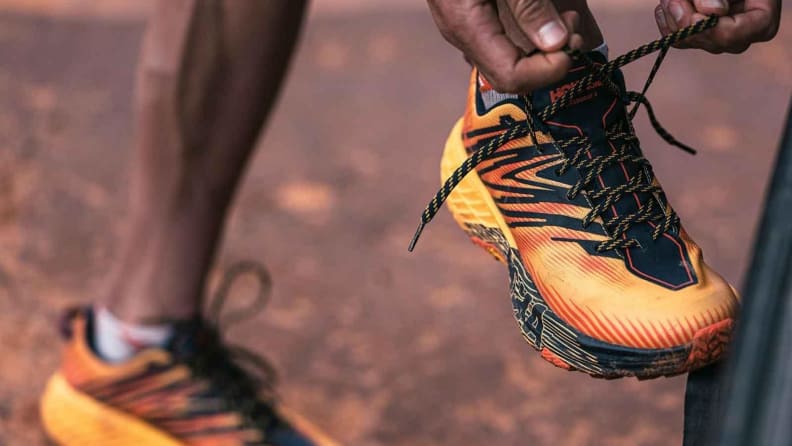
Hoka One One makes maximal shoes for the ultimate cushioning.
Traditional running shoes have a thicker cushion under the heel that thins down toward the toes, in what’s known as “heel-to-toe drop”—a common measurement for this is 10 or 12 millimeters, meaning the sole at the heel is that much thicker than the forefoot. This design suits the lion's share of runners, who land first on their heels and roll through toward the toe to push off, or what’s called “heel striking.”
The whole “which-part-of-your-foot-should-land-first” issue is probably the hottest controversy in terms of running mechanics, and one I’m not going to dig too deeply into here. However, many manufacturers have responded to this by reducing the heel drop, offering lower ratios or even no drop at all. Companies like Altra claim this is more “natural” because there’s less downward slope in the sole to potentially modify your body’s desired gait pattern. Pair that with an overall thin sole, and you have what are called “minimalist” or “barefoot” running shoes, which have a flexible, little-to-no-cushion base that allows the wearer to feel the ground with each footfall. (I personally prefer no-drop shoes because I am a natural midfoot-to-toe striker, and the thicker heels of regular shoes feel like they get in my way.)
On the other hand, some companies, like Hoka One One, make extra-cushioned shoes with thick, often rocker-like soles, sometimes referred to as “maximal.” These provide a lot of padding to soften impact, and the curved shape is designed to offer a smoother ride. Maximal shoes are most popular with runners who are injury-prone or recovering from injury, those who are heavier or who land more heavily on their feet, and those who do run-walk schemes, as the sole shape is particularly conducive to switching back and forth between running and walking.
How long do running shoes last?
The oft-quoted guideline for running-shoe longevity is 300 to 500 miles. As far as ballparks go, though, that’s quite a range. Ultimately, it comes down to wear and tear, both in terms of what you can see and what you can feel. Ground-down treads, separating soles, and abraded fabric are all signs your shoes have logged their last miles. Also, newly developed aches and pains in your feet and legs could indicate that your shoes’ cushioning is no longer absorbing impact adequately.
When should you replace running shoes?
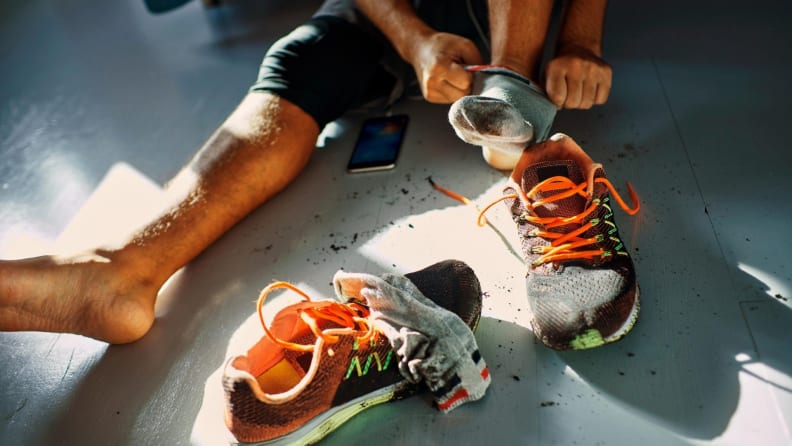
Once your mileage approaches the 300 mark on a pair of shoes, you want to look for signs that it's time to replace them.
Obviously, when your shoes look shabby or pieces of them split or rip, they should be kicked to the curb. But if your running is becoming a habit, a more nuanced shoe strategy may be in order.
When you run, a couple of things happen to your shoes. First, they take a literal pounding, especially road running shoes used primarily on pavement. Second, they tend to get wet (or at least damp) from sweat. For these reasons, shoes should be given at least a day between runs to allow the cushioning to rebound and dry out. If you’re running more than three times a week, adding a second pair of running shoes into the rotation is a good idea—and, if you buy those additional kicks some months after the first one, this also means you’ll have two pairs that are slightly different ages, meaning you’ll always have one pair of old faithfuls while you’re breaking in a new pair.
What do running shoes cost?
This is one of those categories where you can’t cheap out. A good pair of shoes that will support you through the miles is going to cost at least $100—or, at least, that should be the retail price. You can absolutely find great deals on good shoes by shopping discount sites, buying last season’s model, or even trolling Ebay, where a lot of independent shoes stores will list their last pairs of the models they’re closing out on. (This is especially useful if your favorite shoes are later discontinued by the manufacturer.)
Where should you buy running shoes?
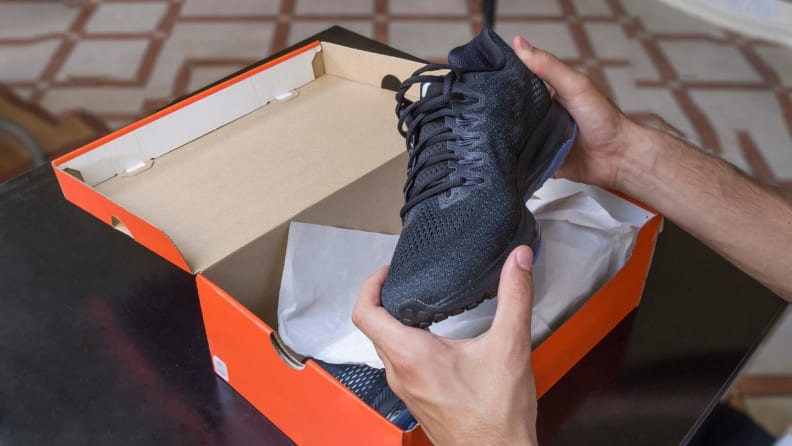
Shop online at sites that have good return policies in case the shoes you order aren't what you expect.
If you’re getting your first pair of shoes or looking to change it up, going to a dedicated running store is the best option. But for those who prefer to shop online, you should shop from a site with a solid return policy. Zappos, for example, offers free shipping and returns on unworn shoes (which you can probably get away with testing out on a treadmill), while REI and Road Runner Sports allow returns of lightly used gear, meaning you can take ‘em outside to really get a feel for them.
Many brands offer similar trial periods, too, including Nike and Brooks Running.





